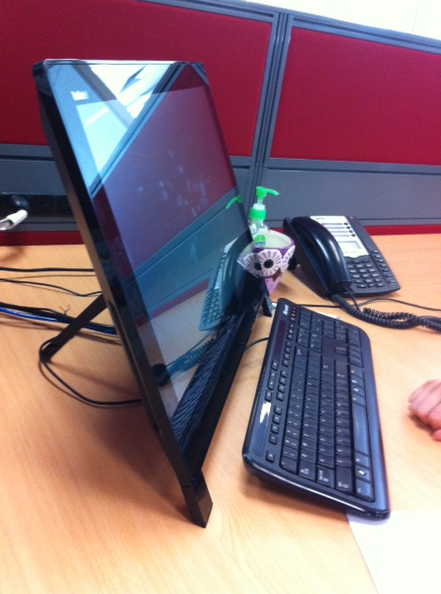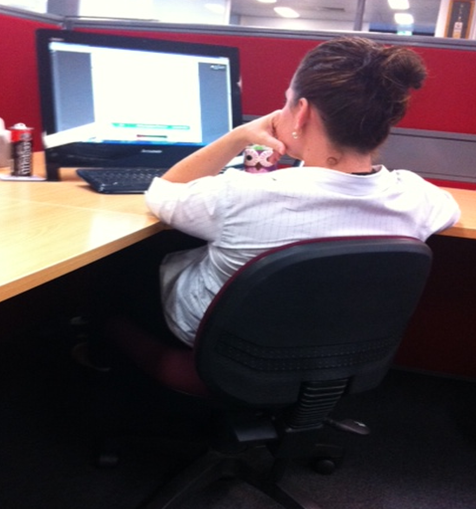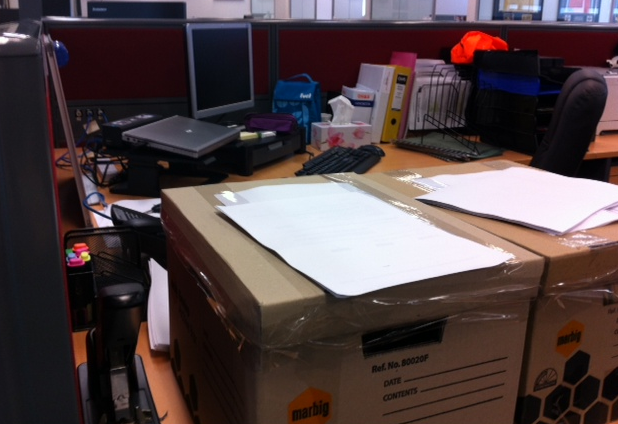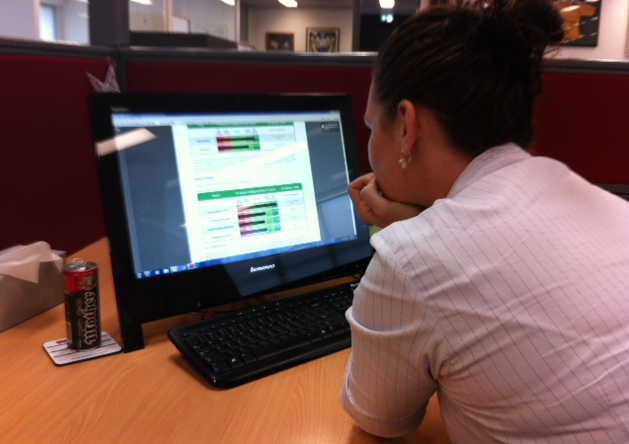Introduction
For the past few decades, concerns over workplace health and safety have been a commonplace. Initially, office workers claimed about poor office environment probably leading to underlying health conditions, which finally affects both the workers and the organization itself. Scientifically, in human beings, both psychosocial and physical factors have an impact at work with employees’ competence depending on such crucial factors to remain successful (Brand 2008). Since scientific studies identified negative health consequences of poor office conditions, research has shifted on the subject of ergonomics. Ergonomics (human factors) is one of the most important scientific disciplines that have stretched and stressed on the concern over understanding how workplace health and safety correlate with employees’ productivity. This paper seeks to provide an ergonomic assessment report based on a support office environment.
Overview of ergonomics in support office
Support office environment is a working atmosphere consisting of several computerized devices that enable smooth running of support office activities. One of the integral administrative activities undertaken by support officers involves proper computation of office work including comprehensive preparation of reports, organizations documents and daily work schedules. Brand (200) affirms, “People who work in offices spend more than 50% of their time interacting with personal computers, laptops, or other similar information technology equipment using keyboards, mice, laser-light pens, trackballs, and various other input modalities” (p. 247). Activities undertaken by support officers during computation of office information involve vigorous typing actions using keyboards and other computer devices, which come with associated negative repercussions on personal health including regular fatigue, headache, backaches and muscle pains among others (Banbury & Berry 2005). Scientifically, severe cases of backaches and fatigue have sometimes resulted in serious health conditions including stroke. Therefore, to ensure proper health during support office activities, it is important for computer users to understand ergonomics.
Health Issues related to Support office activities
Support office work involves a vast number of activities that call for the availability of computers. Continuous use of computers in offices has posed ergonomic issues for workers in their workplace. It is important to note that the visual ability of human beings is equally important to the normal functioning of the entire human body. According to Worksafe Victoria (2006), poorly designed monitors and laxity in computer policies including, “radiation emissions from old CRT monitors not tested within the last 12 months” (p.76) are capable of causing serious eye-related health problem. Support officers are prone to using computer monitors as one of the hardware components of a computer that enable users to view their work during typing or operating the computer. Computer monitors have consistently posed health hazards including eyesight problems that result from excessive eye straining while using computers. Typing is one of the activities that need maximum concentration and frequent monitor checking.
Impacts on efficiency and productivity levels
From the above explanation on the heath issues related to ergonomics in support office setting, it is easy to notice the impact of such ergonomics on work efficiency and productivity levels. Support officers suffering from fatigue and backaches have consequently shown depreciation in their productivity due to discomfort (Lich & Polzella 1990). Fatigue is a state of tiredness, stiffness, numbness, and physical pain that may be due to poor working conditions or psychological state. On the other hand, backache is a painful feeling on the back of the human body that researchers have associated with complications found in the central nervous system. Both health issues are sensitive and normally bring about loss of job morale that finally affects productivity and efficiency among workers. Prolonged and severe back pains, joint pains, and muscle contractions may further result to serious health issues like stroke, which is a permanent body paralysis. Being in stroke condition finally limits the support officer’s ability to undertake complex duties.
Identification of ergonomic issues in support office offices
In the context of addressing the subject matter of the study, the researcher employed personal observation techniques and assessment to identify ergonomic issues related to support office tasks. The researcher undertook direct observation using a walk through inspection of the administrative centers and successive face-to-face interviews with the office Support officers. The researcher comprehensively observed all practices related to the use of computer devices and other related office equipment in the support office offices to ascertain ergonomic issues connected to office material use. Finally, the researcher considered all office structures and office layout to determine ergonomic matters in these offices. In the process of undertaking observations and interviews, the researcher noticed improper use of office facilities including computers, poor office layout, undesirable working positions and poor office lighting coupled with undesirable office furniture positioning, and adjustment. Considering ergonomics in its best definition, all these factors have contributed to breaching of ergonomic principles in the support office offices.
Improper uses of office facilities
Based on personal observations undertaken by the researcher, office facilities in the support office include computers and printers among other important office equipments. Since the most commonly utilized equipment in the support office is the computer, the researcher revealed much on the use of computers. Under the Australian managing and occupational health and safety requirements in the office standards, organizations must “set some basic requirements in the design, development and use of equipment, furniture, plant, and work practices in both office and industrial work environments” (Worksafe Victoria 2006, p.10). Given that most offices in the XYZ Company do not have policies guiding the use of office facilities and equipment, much transpired in the use of use of computers. As computers have become essential office equipments, especially in undertaking most of the office activities, they have consistently posed various ergonomic-related issues within the work environment. Observations in this study noticed several issues related to ergonomics.
Based on the observations, there was poor adjustment of the screen resolution of most CRT monitors, thus causing too much straining of eyesight resulting from glare and reflections. Most support office workers could not ascertain the proper use of swivel and tilt mechanism that enables users to adjust monitors to comfortable positions. According to Worksafe Victoria (2006) “glare occurs when one part of an area is much brighter than the background or vice versa” (p.24). Glares and reflections are capable of causing severe eye fatigue and headaches, thus reducing workers efficiency and productivity. Based on face-to–face conversations and interviews undertaken, several office support workers raised adverse complaints and comments about eye straining and headaches at the end of the workdays. Therefore, to reduce this vice, workers using CRT monitors should receive training on the impacts of monitor glares and reflections as well as support manuals on how to adjust screens using swivel and tilt mechanism and other computer settings. See the following figures

Poor office layout
Office layout is an important aspect that needs considerable attention especially while applying the modernized office arrangement techniques. The researcher observed that workers excessively strained their eyes while working with the computers, with the underlying factor being the office positioning and layout. The support offices lie adjacent to the stores, which makes it difficult for support workers to concentrate due to noise generating activities from the stores. There was excess volume of noise generated throughout various times of the day. The offices have posed several health issues including eye stressing according to comments and complaints produced by workers in the support offices. Poor office layout is against the Occupational Health and Safety Act 2004. Worksafe Victoria (2006) asserts, “An important feature of modern office design is the need for flexibility in office layout, furniture, equipment and the environment to suit the needs of the users and the work they perform” (p.31). Therefore, to amend this situation, restricting the offices is necessary to protect workers from noise.
Another inclusion in the structuring and positioning of the office is the aspect of poor office lighting, which has persisted for several years since the beginning of the XYZ Company. Coupled with poor positioning of computers and monitors in the support office, the office window pens allow heavy light, which reflects directly into the eyes thus causing eyestrains. Brown, Albert and Croll (2007), point out that many offices use general lighting that allows too much lighting which results in glares that associate with sore eyes, headaches, and poor vision. Based on face-to-face conversations and interviews undertaken in the support office department, workers outlined several symptoms of eye problems.

Undesirable office furniture positioning and adjustment
XYZ is a modern and competent company based on the services provided to the physical environment surrounding its operations. Despite its fancy offices, which are furnished in almost the best furniture available around them, the positioning and adjustment of the furniture remains undesirable. XYZ Company is one of the companies that have invested intensively in office equipments, but the means of furniture adjustment and positioning by workers remains questionable. Based on observations undertaken, chairs were either in a higher position than the computer desks and tables, or relative lower than the tables. Face-to-face interviews conducted in the support offices in XYZ involved several fatigue and backache claims from the office workers. Coupled with poor sitting postures, improper furniture positioning, structuring and adjustment may consequently result in fatigue, lumber backaches, and other related problems (Brand 2008). Based on personal observations undertaken by the researcher, the seating of the support office has ignored important considerations related to user-centered seating design. See the photo below:

Poor office arrangement
The support office is one of the busiest offices in XYZ with several activities taking place throughout the week. Due to this aspect, the office arrangement remains dubious with no proper arrangement practices. The researcher observed several malpractices associated with arrangement practices of support office and housekeeping practices. The researcher observed office congestion with the following: desk spaces filled with lots of documents, boxes, and various office supplies on a normal reporting week, whiteboards placed in an awkward position and at 80cm away from the edge of the desk. In addition, there were computer & electrical cables placed at the back of computers on desks coupled with poor location of penholders among other several ergonomic hazards.

Poor sitting postures
The support office job involves long working hours characterized by long sitting, which research has identified to have an impact on individuals’ personal health. In several occasions, support office workers have found themselves working for extra hours to reach the organizational demands in a single day. Scientists have connected long sitting with backaches and fatigues, which are normally serious health issues to office workers. Lich and Polzella (1990) observe, “Sitting is active, involving motion, balance, position, posture, and control…sitting is an innate behavior involving both body and mind” (p. 1). In terms of posture, team members often will lean over to review documents with back and neck placed in an awkward position, elbows rested on the desk. Since the advent of ergonomics and its related studies, researchers have identified sitting and seating as two things that directly relate to each other (Banbury & Berry 2005). For employees, especially those working in offices like the Support officers to enjoy their work, it is important for them to have proper seating. With poor seating devices, support officers are likely to suffer from sitting disorders including fatigue and backaches. See the photo below.

Recommended control strategies
Based on the hierarchy of controls, any risk assessment that portrays the ability of causing harm, it is important to find possible ways of eliminating the risks. According to the principles of hierarchy, there are several means of eliminating or controlling ergonomic hazards including isolation, substitution, engineering, administration, and using personal protective equipment (PPE) (Brown, Albert & Croll 2007). Based on the findings of the observations undertaken, the main types of hazard present in your support office under the study were physical hazards and a few psychological hazards. In terms of physical ergonomic hazards established, glares and reflections were the main potential hazards in the support office resulting from excessive lighting and poor adjustment of computer monitors and screens. Psychological hazards within the ergonomic issues were minimal, but the researcher observed excessive workloads under pressure characterized by excessive periods of seated work that resulted in psychological strains. Therefore, to control such ergonomic hazards, this study concluded and recommended the following.
Possible conclusion and recommendation
It is important for the company to consider quick remedies following the principles of hierarchy in which administrative approaches can apply including providing appropriate training to support officers on how to adjust their monitors to avoid physical hazards like glares and reflections. It is also important for the company’s risk management department to evaluate the extent of risk associated with computer use and set up risk control measures (Worksafe Victoria 2006). Employers in this company should understand the need to keep information and records pertaining to the health and safety of their employees. On the psychological hazard issues, it is important to consider medical attention to see the extent of psychological effects experienced so far. The support office may need restructuring to avoid heavy light, improve seating, and shelving coupled with enhancing office user comfort. Based on the hierarchy of control on workers already seriously affected by ergonomic issues, it is essential for the company to consider isolation of the hazard from such workers.
References
Banbury, P & Berry, C 2005, ‘Office noise and employee concentration: Identifying causes of disruption and potential improvements’, Ergonomics, vol.48 no.1, pp. 25–37.
Brand, J 2008, ‘Office Ergonomics: A Review of Pertinent Research’, Reviews of Human Factors and Ergonomics, vol. 4 no. 1, pp. 245-282.
Brown, N, Albert, J & Croll, J 2007, ‘A new input device: Comparison to three commercially available mouses’, Ergonomics, vol. 50 no.2, pp. 208–227.
Lich, D & Polzella, J 1990, Human Factors, Ergonomics, and Human Factors Engineering: An Analysis of Definitions. Web.
Worksafe Victoria: Officewise – A guide to health & safety in the office 2006. Web.
